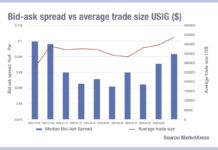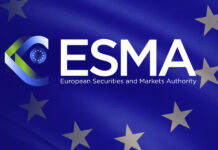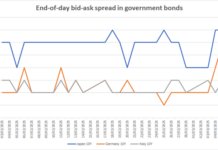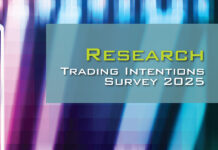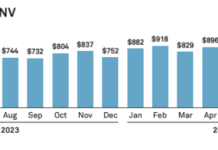The battle for pre-trade analytics
The 2025 Trading Intentions Survey canvassed 40 buy-side trading desks across asset managers headquartered in Europe (52%) and the US (48%), to understand which platforms and service they are using to picture, engage with and execute in primary and secondary corporate bond markets. The majority of respondents trade on behalf of active, long only strategy funds, but also represent passive and hedge fund strategies. Their assets under management range from between US$50 billion to well over US$1 trillion.
Summary
Pre-trade data and analytics is a battleground at present, which had historically been held solidly by trading venues and the standalone Neptune. This year new combatants are entering the fray, with Propellant Digital and Glimpse Markets both showing their mettle.
Within trading interfaces the incumbents are in a solid position, although Charles River, FlexTrade and Trumid have all seen strong, positive growth.
DirectBooks is holding second place in primary markets, but Bloomberg’s IB/Chat still dominates and little change has been seen this year.
Finally, amongst trading platforms rankings have largely held firm, although Trumid has seen clear activity increase. The two largest order management systems (OMSs) are increasingly used for actual trading, according to their users, and dealers’ streamed prices are being used to trade against more than ever, breaking their curse of offering information, but not execution.

Pre-trade insights
Pre-trade data/analytics is the most open category for competition, measured by the low proportional number of users who categorise themselves as ‘major users’ of incumbents when set against user interfaces, and primary or secondary trading platforms.
That suggests there is greater scope for both incumbents and new entrants to compete for market share in pre-trade data than any part of the corporate bond trading workflow.
The most-used pre-trade data and analytics source is Bloomberg, with 86% of respondents using it and 31% classifying themselves as ‘major users’ of it. The next most used data and analytics source is MarketAxess, whose TraX data, which follows activity across multiple markets, and CP+ pricing tool, delivers a composite price based on actual executed trades, which are collectively used by 74% of respondents. Tradeweb’s pre-trade data tools are the next most utilised (69% of respondents), rounding off the top three platforms of providers.

The second layer is led by streamed prices from dealers, which continue to be used as an input from dealers to a far greater extent than they are used as an execution source.
Axe streaming service Neptune is the next most used service, with 47% of users, and has the second largest proportion of ‘major users’ at 21%. Proprietary trading tools are the third in that segment, with 46% of total users but just 8% major users.
At the third level are a mix of more established players like Liquidnet and ICE Data, but also new players like analytics provider Propellant, which in just three years has taken an 18% chunk of users, with 3% declaring themselves major users, and Glimpse Markets which has a 10% share of respondent buy-side desks using it. It is worth noting that 10% of respondents also plan to use Propellant, giving it the largest runway for any analytics vendor, while Glimpse, ICE and MarketAxess all have 8% planning to use them.
View of the market
Interfaces for trading into the market include those that are native to trading platforms, third-party systems that connect to platforms and text-based communication tools. These do not necessarily manage the execution of trades but collectively allow traders to view the market liquidity and pricing, pre-, at- and post-trade in order to help manage orders.
The most commonly used interface is Bloomberg IB/Chat (90% of respondents), which has been supplemented by natural language analysis by the firm so that its activity can be brought into scope of more systematised workflows. This has supported its ‘major user’ activity to 59% of respondents, making it the most relied upon interface.

The most used dedicated trading interface is that of MarketAxess, used by 82% of traders in the survey, with 46% being major users. Tradeweb’s GUI is the third most used, with 66% of respondents accessing it and half of those stating they are major users.
The second rank of interfaces used is led by Bloomberg’s E/OMS offerings, in play with 49% of respondents. Charles River, Trumid, UBS Bond Port and Liquidnet take the next positions in that category respectively. Of those, Charles River appears to be the second most used E/OMS system in the market behind Bloomberg. Two thirds of Charles River users are ‘major users’, making it one of the most embedded interfaces in the market. Trumid’s interface is now engaged by 26% of respondents of whom half are major users, representing a 76% growth in market share year-on-year.

Assessing growth, FlexTrade has hit 10% of users this year, all of whom are major users, unique amongst platforms with double digit levels of use and adding weight to the case for a real evolution of execution management systems (EMSs) in the past twelve months.
Two other notable growth stories are MTS and LTX. MTS expanded into Euro credit trading late last year and clearly has seen increased use of the back of that initiative, while LTX has been employing innovative AI technology to help traders identify which bonds they can engage with and this is yielding results.
Primary progress
 In primary markets the level of usage has not changed markedly since 2024, with Bloomberg’s IB/Chat still the dominant method of communication by a considerable margin. DirectBooks has maintained its position in second place but the skew in favour of US respondents this year appears to have reduced the proportion of InvestorAccess users, who are primarily engaged in primary markets outside of the US. While DirectBooks has its largest user base in the US, Trumid’s service, which supports grey market trading, is also US focused and has seen a big pick-up since last year, rising to 11% of users from 3% in 2024.
In primary markets the level of usage has not changed markedly since 2024, with Bloomberg’s IB/Chat still the dominant method of communication by a considerable margin. DirectBooks has maintained its position in second place but the skew in favour of US respondents this year appears to have reduced the proportion of InvestorAccess users, who are primarily engaged in primary markets outside of the US. While DirectBooks has its largest user base in the US, Trumid’s service, which supports grey market trading, is also US focused and has seen a big pick-up since last year, rising to 11% of users from 3% in 2024.
Eighteen percent of respondents say they plan to use DirectBooks, while 8% for Investor Access and for Liquidnet’s Primary Market offering.

Pole position in secondary
The secondary trading of corporate bonds has shown to be a hard market to break into. Bloomberg and MarketAxess have long been the leading platforms for buy-side users, closely followed by Tradeweb, and with 84%, 79% and 71% they have maintained their positions in 2025.

The second rank is headed up by Liquidnet, which has fought hard to innovate in the past two years, including via listed derivatives markets, and is preparing to absorb Neptune. It has the largest pipeline for new business with 8% of desks planning to onboard it. UBS Bond Port maintains its fifth place position, still the only successful dealer-run multi-dealer platform in the corporate bond market. Trumid now has 26% of respondents trading on its venue, up from 15% in 2024, a significant rise, and also reflective of the larger participation from US respondents this year.
Given that 48% of respondents use streamed prices from dealers as an input in pre-trade analysis, the level of trading against them (16%) is relatively low, and may reflect that some firms stream indicative pricing more than executable prices, creating a disconnect between their use as an input and their viability guiding trading. Nevertheless, that 16% is considerably higher than the proportion trading against them in 2024 (3%) which indicates at least some banks have really upped their capabilities in streamed, executable pricing.

Better execution
Trading on platforms has been transformed by the growing range of trading protocols available to buy-side desks. Although request-for-quote (RFQ) is still the most commonly used trading method, it has serious competition from other protocols.
In 2021 RFQ was the preferred method, used by 47% of respondents when on Bloomberg, 39% using MarketAxess and 46% of users on Tradeweb.
Bloomberg now has a much greater diversity of trading methods. RFQ is only preferred on Bloomberg by 28% of respondents, with bilateral trading and processed trading now used by 21% each.

 MarketAxess has seen all-to-all increase in popularity to the point it nearly makes up half of trades, with 36% of all respondents preferring all-to-all on the platform against 38% preferring RFQ. Tradeweb’s greatest growth has been in portfolio trading, which is now preferred by 18% of all respondents when they use the platform, up from 2% in 2021.
MarketAxess has seen all-to-all increase in popularity to the point it nearly makes up half of trades, with 36% of all respondents preferring all-to-all on the platform against 38% preferring RFQ. Tradeweb’s greatest growth has been in portfolio trading, which is now preferred by 18% of all respondents when they use the platform, up from 2% in 2021.
Platforms that have a smaller proportion of respondents using them – such as Liquidnet, UBS Bond Port and Trumid – still show the value of innovation, each seeing interest in multiple trading protocols. The greatest growth story of these, Trumid, has seen its trading protocols expand from three to five over the last years, which may tie to its expanded use.
In assessing performance of platforms, MarketAxess is reckoned to be most effective at finding liquidity across all venues, interfaces and pre-trade data sources, followed by Bloomberg’s messaging tools, and Tradeweb.
The estimates of which groups could create additive liquidity in the market are still across dealers, electronic liquidity providers and buy-side investors, in that order. This year these are estimated to be placed in far closer in their capabilities than in previous years, giving the buy side a much more prominent role, in its own estimation.
For more information on Neptune click here
For more information on DirectBooks click here
©Markets Media Europe 2025




